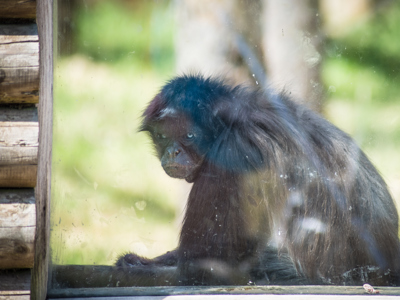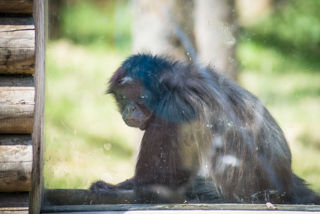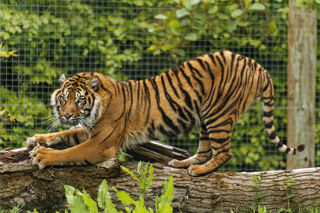
Variegated spider monkey
Spider monkeys are named for their long, narrow limbs and long, prehensile (gripping) tail. Their tail can be up to 75cm long and has a hairless pad on the end used for gripping branches. Variegated spider monkeys range in colour from light to dark brown but all have lighter buff patches on the underside of their arms, legs and tail. Most have a crest of white fur on the forehead.

Variegated spider monkeys live in multiple male and female fission-fusion groups, which means the group splits off into several smaller sub-groups for foraging. Greetings are enthusiastic and involve vocalisations, hugging with entwined tails and chasing. Spider monkeys use a wide variety of calls to communicate with other sub-groups as well as scaring away predators or defending their territory.
Females will mate with multiple males which is thought to lessen the risk of infanticide (killing of infants) by unrelated males. Infants are dependent upon their mothers for the first 18 months providing an extended period of learning and creating a strong bond between mother and infant. Females will only reproduce every three to four years.

The preferred diet for the variegated spider monkey is ripe fruit (83%). During drier seasons they supplement their diet with other plant material such as flowers.
The major threats to variegated spider monkeys are habitat destruction for agriculture and hunting for food. This has led to a decline in numbers and they are now classed as Critically Endangered by the IUCN.
Key Facts:
Conservation Status: Critically Endangered
Distribution: Colombia, Venezuela
Habitat: Tropical Forest
Diet: Flowers, Fruit, Leaves, Seeds
Height: 50cm
Weight: 7.5 – 9kg
Gestation: 7.5 months
No. of young: 1
Life Span: 27 years

SUPPORT OUR ANIMALS
If you're looking for an alternative way to donate to Twycross Zoo, you can help support our animals and our zoo keepers by purchasing something from our Amazon Wishlist!
Updated regularly by our zoo keepers, the items on the list help to provide enrichment for our animals and keep their habitats well maintained.
Every donation helps us as a conservation charity.

